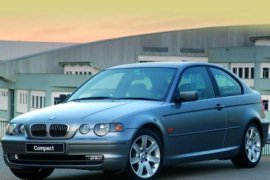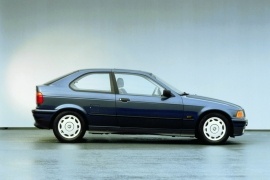BMW 3 Series Compact Models/Series Timeline, Specifications & Photos
First production year: 1994
Engines: Gasoline, Diesel
Body style: Hatchback
After its first attempt to create an affordable, compact-sized premium hatchback, BMW tried again with a second generation of the 3 Series Compact and then stopped.
BMW unveiled the three-door hatchback model at the 2001 Geneva Motor Show, and the audience was shocked when the wraps were off from the car’s front. It didn’t have anything in common with the 3 Series. Moreover, it had nothing in common with any other BMW in history, bar the kidney grille. The automaker tried in vain to convince customers that it was a lightweight, fun-to-drive RWD hatchback. Unfortunately, the car had many shortcomings, and that affected sales. Even though it was powered by the same engines as the rest of the E46 lineup, the E46/5 (factory code) was a different kind of vehicle. It also relied on older parts, such as the rear axle, which was a trailing arm carried over from the 3 Series E30.
The front fascia was one of the most polarizing parts of the vehicle. In fact, most customers considered the car to be outright ugly. For sure, it didn’t win any beauty contests, but it wasn’t scrap metal, either. Its headlights, even though they were one-part units, appeared like two distinct parts, one for the high beams mounted towards the car’s center and the outer area for the low beams and parking lights. In addition, the turn signal lamps were independent pieces that looked integrated into the main headlight units. On the lower side of the bumper, BMW installed a broad air intake.
From its profile, the 2001 BMW 3 Series Compact E46/5 showed its short front overhang and a long hood compared to the rest of the vehicle. Since it shared most of its underpinnings with the E46 lineup, the automaker created front fenders that looked like they were carried over from the rest of the range, although these were unique to the Compact version. BMW didn’t cheap out with the vehicle and created specific doors for it instead of getting the frameless ones from the 3 Series Coupe (E46). To quickly vent the cabin, since only the front windows could open, the automaker used a pop-out system for the side rear glass areas. Finally, at the back, the large tailgate featured a wiper and designated taillights with clear covers.
Inside, customers had a wide choice of features and interior trims. The high-bolstered seats kept their occupants in place during high-speed cornering maneuvers. In the back, the second generation of the 3 Series compact provided more headroom, although that affected the overall look of the vehicle. Drivers fronted a four- or three-spoke steering wheel. The dashboard was borrowed from the E46 lineup with an integrated center console and tons of features.
Under its skin, the E46/5 3 Series Compact relied on a modified E46 platform. While upfront, it relied on McPherson struts, the rear axle was borrowed from the E30 lineup. The engine range was respectable and included fuel-efficient diesel powerplants. All versions were paired with five-speed manuals, while a five-speed automatic was available.
BMW dug deep into its history books and found the 2002 Touring model from 1971, which was a hatchback based on the 2002 platform, and considered reviving it into the shape of the 1994 E36 Compact.
The German automaker noticed that many customers were interested in buying upscale compact-sized hatchbacks, and there were no European automakers to provide one. As a result, it quickly gathered the engineering team, recycled some already developed parts and engines, and launched the 3 Series Compact in 1994. The result was a three-door vehicle that looked like an E36 3 Series from the front but had a tailgate at the back. It was also cheaper to produce despite the considerable development cost. However, even though the new version of the 3 Series was more affordable, it wasn’t the best-selling among its siblings. Furthermore, the concept of a rear-wheel drive vehicle that competed against the front-wheel drive Golf didn’t work as expected. To add insult to injury, the rear axle was carried over from the previous generation of the 3 Series, the E30, which used a semi-trailing arm system instead of the fully independent type installed in the E36.
To cut production costs, all the body panels from the car’s front were taken from the same basket as those installed on the E36. As a result, the 1994 3 Series Compact sported rectangular headlights fitted with corner-mounted turn signals. The kidney grille was integrated into the wrapped around plastic bumper, and was encircled by chromed trims. Depending on the grade and options, the car could sport fog lamps in the front apron.
From its profile, the car looked identical to the E36 sedan up to the B-post. Its short overhang and flared wheel arches made it look sporty. Its doors had frames for the windows, unlike the coupe and the convertible versions of the E36, which had those frameless. Behind them, the rear side windows featured a pop-out compass-style mechanism that allowed customers to vent the cabin efficiently. Finally, at the back, the raked-forward tailgate was new for a Bimmer. It also featured a wiper, but the taillights that flanked it were carried over from the E36 as well. The car came fitted with 15-inch steel wheels or available alloys of the same size.
Inside, the overall look resembled the E36 coupe. Its tilt-forward front seats could be wrapped in fabric or leather, depending on the options. The dashboard looked identical to the one in the rest of the E36, albeit it was made from lower-quality materials. Between the front occupants, the automaker placed a narrow center console that housed the buttons for the power windows and the gear stick (or gear selector, depending on the transmission). At the same time, in the back, BMW placed a new split-folding (50/50) bench seat. It provided minimal legroom and headroom for adult-sized passengers, but it was perfectly fine for kids. BMW created a decently-sized trunk for a compact hatchback. To make it roomier, the automaker placed the spare wheel under the car.
Under the hood, the 1994 BMW 3 Series Compact (E36/5) was available with a choice of gasoline and diesel engines, with four or six cylinders. All versions were paired with a five-speed manual, while a four-speed automatic was available.
BMW 3 Series Compact (E36) 316i 4AT RWD (102 HP)
BMW 3 Series Compact (E36) 316i 4AT RWD (105 HP)
BMW 3 Series Compact (E36) 316i 5MT RWD (102 HP)
BMW 3 Series Compact (E36) 316i 5MT RWD (105 HP)
BMW 3 Series Compact (E36) 318ti 4AT RWD (140 HP)
BMW 3 Series Compact (E36) 318ti 5MT RWD (140 HP)

